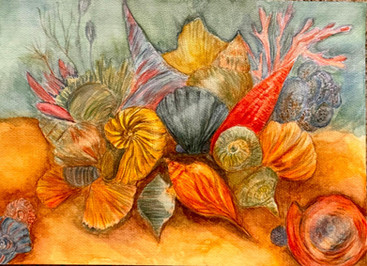My Artistic Evolution
- Jentok

- Mar 20
- 2 min read
Updated: Apr 3
Studying at NAFA has given me the opportunity to explore both watercolor and oil painting in-depth, developing my skills while refining my personal artistic voice. Through my journey, I’ve come to appreciate how these mediums allow for different forms of expression—the fluidity and transparency of watercolor versus the richness and depth of oil paint. My approach is deeply influenced by the Fluidity and Structure concept, emphasizing the duality of experimentation and structured techniques in art.
This blog portfolio serves as a reflection on what I have learned from NAFA’s curriculum, my own explorations, and how I intend to apply these techniques in future works.
Fluidity & Structure: The Dual Approach in My Art
I have embraced the Fluidity & Structure approach, which balances structured learning with artistic freedom.
Fluidity (Freedom & Exploration) – Encouraging spontaneity, intuition, and playfulness in my creative process. This is evident in my watercolor works, where I let the pigments flow freely, embracing happy accidents.
Structure (Foundation & Discipline) – Understanding the fundamental techniques, color theory, and composition planning to create impactful artworks. This is where my oil paintings excel, as they allow for careful layering and texture work.
The combination of both methodologies enables me to create concept-driven paintings that are both expressive and technically refined.
Key Takeaways in Watercolour & Oil Painting
1. Watercolour: The Art of Fluidity & Spontaneity
Through various studio exercises and projects, I have developed:
Wet-on-Wet & Wet-on-Dry Techniques – Understanding how water affects pigment diffusion to create soft transitions or crisp edges.
Layering for Depth – Building up transparent layers to add richness while maintaining luminosity.
Negative Space & Lifting Techniques – Controlling highlights and defining elements within compositions.
Colour Harmony & Mood Creation – Using controlled washes to evoke emotion and atmosphere.
Watercolour has helped me embrace fluidity and unpredictability, pushing me to adapt and make intentional choices throughout my process.
2. Oil Painting: The Power of Texture & Depth
Oil painting, in contrast, has taught me patience, layering, and controlled blending:
Glazing for Luminous Effects – Applying thin transparent layers to create depth.
Impasto Techniques for Texture – Using thick applications of paint to enhance tactile quality.
Blending & Gradation – Achieving smooth transitions in colour and tone.
Extended Workability – The slow drying time allows for detailed refinements and colour mixing directly on the canvas.
Through oil painting, I have learned how to manipulate light, shadow, and texture to enhance realism and atmosphere in my work.
Applying These Learnings in Future Works
Moving forward, I aim to:
Merge Watercolor & Oil Painting – Experimenting with mixed-media approaches, combining watercolor’s fluid expressiveness with oil’s rich textural qualities.
Expand Conceptual Narratives – Using both mediums to tell compelling stories through symbolism, metaphor, and emotional depth.
Explore Sustainability in Art – Investigating how natural pigments, eco-friendly materials, and sustainable painting methods can be incorporated into my practice.
Teach & Share Knowledge – Applying what I’ve learned to mentor and facilitate workshops that encourage others to explore both disciplines.
Final Thoughts
My journey through watercolour and oil painting has been one of continuous discovery and refinement. NAFA has provided me with a structured foundation while also encouraging me to push boundaries and experiment.
By integrating Fluidity’s exploratory spirit with Structure’s technical rigor, I strive to create art that not only resonates visually but also carries meaningful narratives. Each brushstroke is a reflection of growth, curiosity, and endless possibilities. 🎨✨
















Comments